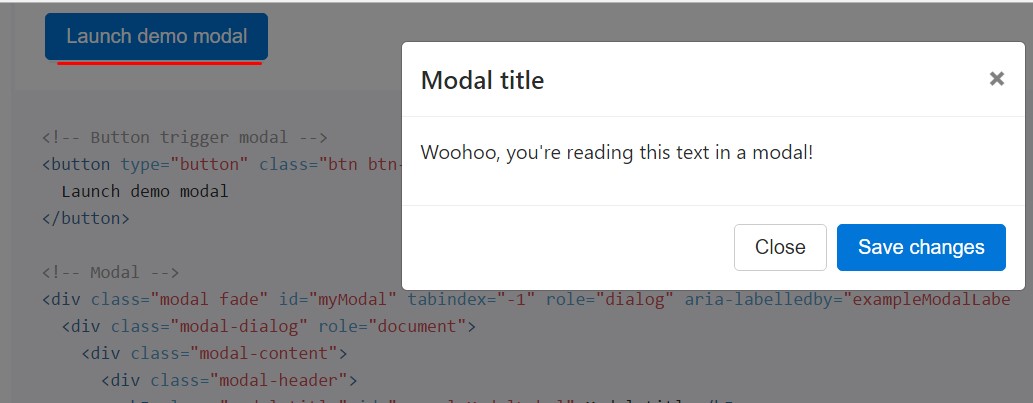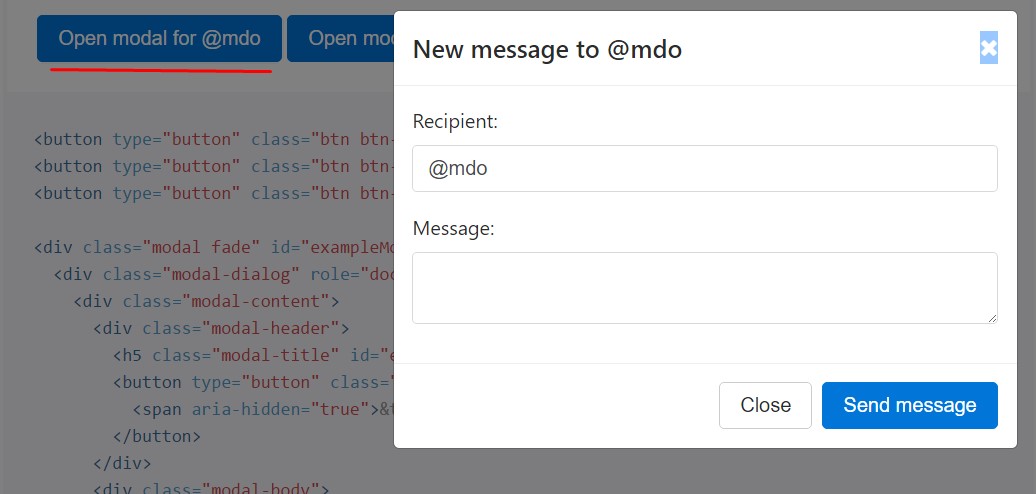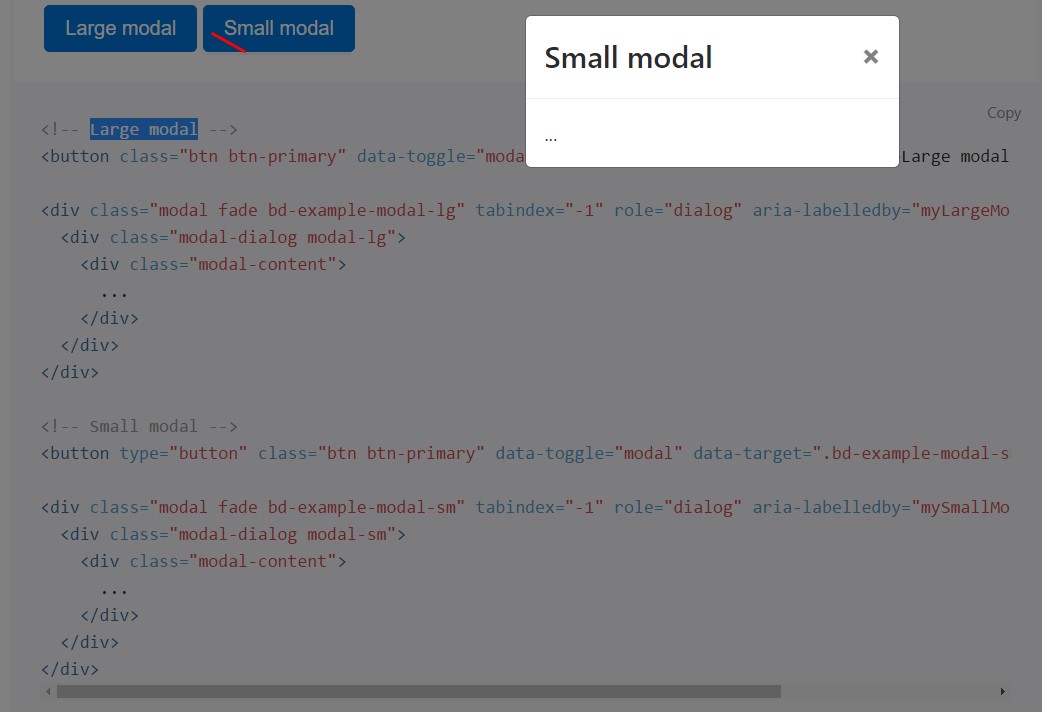Bootstrap Modal Position
Introduction
In some instances we really should fix the concentration on a certain info leaving anything others obfuscated behind making certain we have indeed got the targeted visitor's concentration or even have plenties of info wanted to be obtainable through the page still, so massive it absolutely will bore and push the person digging the page.
For these scenarios the modal feature is certainly invaluable. What it does is presenting a dialog box operating a great field of the monitor diming out whatever else.
The Bootstrap 4 framework has every thing desired for producing this sort of element along with the minimum initiatives and a basic user-friendly building.
Bootstrap Modal is streamlined, and yet variable dialog assists powered with JavaScript. They maintain a variety of use samplings from user alert ending with completely custom web content and come with a handful of valuable subcomponents, scales, and much more.
Information about how Bootstrap Modal Content performs
Right before getting started by using Bootstrap's modal component, don't forget to check out the following because Bootstrap menu options have currently improved.
- Modals are built with HTML, CSS, and JavaScript. They're located over anything else in the documentation and remove scroll from the
<body>- Selecting the modal "backdrop" is going to quickly finalize the modal.
- Bootstrap simply just holds one modal window at a time. Nested modals usually are not supported while we believe them to be unsatisfactory user experiences.
- Modals usage
position:fixeda.modal- One once again , due to
position: fixed- In conclusion, the
autofocusContinue reviewing for demos and usage guidelines.
- As a result of how HTML5 identifies its semantics, the autofocus HTML attribute comes with no result in Bootstrap modals. To reach the very same effect, put into action some custom-made JavaScript:
$('#myModal').on('shown.bs.modal', function ()
$('#myInput').focus()
)To set up we need to get a switch on-- an anchor or switch to get hit in turn the modal to get presented. To achieve in this way simply specify
data-toggle=" modal"data-target="#myModal-ID"Instruction
Now why don't we generate the Bootstrap Modal itself-- initially we need to get a wrapping element incorporating the whole aspect-- delegate it
.modalA smart idea would be additionally including the
.fadeYou would undoubtedly also really want to put in the identical ID that you have already defined in the modal trigger because otherwise if those two really don't suit the trigger won't actually launch the modal up.
If this has been completed we desire an special element holding the actual modal material-- delegate the
.modal-dialog.modal-sm.modal-lg.modal-content.modal-header.modal-bodyOptionally you might possibly really want to incorporate a close tab in the header specifying it the class
.closedata-dismiss="modal"Essentially this id the design the modal features have in the Bootstrap framework and it pretty much has kept the equivalent in both Bootstrap version 3 and 4. The new version possesses a number of new approaches though it seems that the dev crew thought the modals do work all right the way they are and so they made their interest away from them so far.
Right now, lets check out at the several forms of modals and their code.
Modal elements
Here is a static modal example ( signifying its
positiondisplaypadding<div class="modal fade">
<div class="modal-dialog" role="document">
<div class="modal-content">
<div class="modal-header">
<h5 class="modal-title">Modal title</h5>
<button type="button" class="close" data-dismiss="modal" aria-label="Close">
<span aria-hidden="true">×</span>
</button>
</div>
<div class="modal-body">
<p>Modal body text goes here.</p>
</div>
<div class="modal-footer">
<button type="button" class="btn btn-primary">Save changes</button>
<button type="button" class="btn btn-secondary" data-dismiss="modal">Close</button>
</div>
</div>
</div>
</div>Live demo
Whenever you are going to employ a code listed here - a training modal test is going to be provided as showned on the image. It will certainly slide down and fade in from the very top of the webpage.

<!-- Button trigger modal -->
<button type="button" class="btn btn-primary" data-toggle="modal" data-target="#exampleModal">
Launch demo modal
</button>
<!-- Modal -->
<div class="modal fade" id="myModal" tabindex="-1" role="dialog" aria-labelledby="exampleModalLabel" aria-hidden="true">
<div class="modal-dialog" role="document">
<div class="modal-content">
<div class="modal-header">
<h5 class="modal-title" id="exampleModalLabel">Modal title</h5>
<button type="button" class="close" data-dismiss="modal" aria-label="Close">
<span aria-hidden="true">×</span>
</button>
</div>
<div class="modal-body">
...
</div>
<div class="modal-footer">
<button type="button" class="btn btn-secondary" data-dismiss="modal">Close</button>
<button type="button" class="btn btn-primary">Save changes</button>
</div>
</div>
</div>
</div>Scrolling extensive content
They scroll independent of the page itself when modals become too long for the user's viewport or device. Work the test below to see what exactly we show ( more tips here).

<!-- Button trigger modal -->
<button type="button" class="btn btn-primary" data-toggle="modal" data-target="#exampleModalLong">
Launch demo modal
</button>
<!-- Modal -->
<div class="modal fade" id="exampleModalLong" tabindex="-1" role="dialog" aria-labelledby="exampleModalLongTitle" aria-hidden="true">
<div class="modal-dialog" role="document">
<div class="modal-content">
<div class="modal-header">
<h5 class="modal-title" id="exampleModalLongTitle">Modal title</h5>
<button type="button" class="close" data-dismiss="modal" aria-label="Close">
<span aria-hidden="true">×</span>
</button>
</div>
<div class="modal-body">
...
</div>
<div class="modal-footer">
<button type="button" class="btn btn-secondary" data-dismiss="modal">Close</button>
<button type="button" class="btn btn-primary">Save changes</button>
</div>
</div>
</div>
</div>Tooltips and popovers
Tooltips along with popovers can be localised within modals as needed. When modals are closed, any tooltips and popovers within are at the same time instantly rejected.

<div class="modal-body">
<h5>Popover in a modal</h5>
<p>This <a href="#" role="button" class="btn btn-secondary popover-test" title="Popover title" data-content="Popover body content is set in this attribute.">button</a> triggers a popover on click.</p>
<hr>
<h5>Tooltips in a modal</h5>
<p><a href="#" class="tooltip-test" title="Tooltip">This link</a> and <a href="#" class="tooltip-test" title="Tooltip">that link</a> have tooltips on hover.</p>
</div>Putting to use the grid
Work with the Bootstrap grid system within a modal by simply nesting
.container-fluid.modal-body
<div class="modal-body">
<div class="container-fluid">
<div class="row">
<div class="col-md-4">.col-md-4</div>
<div class="col-md-4 col-md-offset-4">.col-md-4 .col-md-offset-4</div>
</div>
<div class="row">
<div class="col-md-3 col-md-offset-3">.col-md-3 .col-md-offset-3</div>
<div class="col-md-2 col-md-offset-4">.col-md-2 .col-md-offset-4</div>
</div>
<div class="row">
<div class="col-md-6 col-md-offset-3">.col-md-6 .col-md-offset-3</div>
</div>
<div class="row">
<div class="col-sm-9">
Level 1: .col-sm-9
<div class="row">
<div class="col-8 col-sm-6">
Level 2: .col-8 .col-sm-6
</div>
<div class="col-4 col-sm-6">
Level 2: .col-4 .col-sm-6
</div>
</div>
</div>
</div>
</div>
</div>A variety of modal material
Contain a bunch of buttons that activate the identical modal with slightly diverse materials? Employ
event.relatedTargetdata-*Listed here is a live test complied with by example HTML and JavaScript. For additional information, check out the modal events docs for information on
relatedTarget

<button type="button" class="btn btn-primary" data-toggle="modal" data-target="#exampleModal" data-whatever="@mdo">Open modal for @mdo</button>
<button type="button" class="btn btn-primary" data-toggle="modal" data-target="#exampleModal" data-whatever="@fat">Open modal for @fat</button>
<button type="button" class="btn btn-primary" data-toggle="modal" data-target="#exampleModal" data-whatever="@getbootstrap">Open modal for @getbootstrap</button>
<div class="modal fade" id="exampleModal" tabindex="-1" role="dialog" aria-labelledby="exampleModalLabel" aria-hidden="true">
<div class="modal-dialog" role="document">
<div class="modal-content">
<div class="modal-header">
<h5 class="modal-title" id="exampleModalLabel">New message</h5>
<button type="button" class="close" data-dismiss="modal" aria-label="Close">
<span aria-hidden="true">×</span>
</button>
</div>
<div class="modal-body">
<form>
<div class="form-group">
<label for="recipient-name" class="form-control-label">Recipient:</label>
<input type="text" class="form-control" id="recipient-name">
</div>
<div class="form-group">
<label for="message-text" class="form-control-label">Message:</label>
<textarea class="form-control" id="message-text"></textarea>
</div>
</form>
</div>
<div class="modal-footer">
<button type="button" class="btn btn-secondary" data-dismiss="modal">Close</button>
<button type="button" class="btn btn-primary">Send message</button>
</div>
</div>
</div>
</div>$('#exampleModal').on('show.bs.modal', function (event)
var button = $(event.relatedTarget) // Button that triggered the modal
var recipient = button.data('whatever') // Extract info from data-* attributes
// If necessary, you could initiate an AJAX request here (and then do the updating in a callback).
// Update the modal's content. We'll use jQuery here, but you could use a data binding library or other methods instead.
var modal = $(this)
modal.find('.modal-title').text('New message to ' + recipient)
modal.find('.modal-body input').val(recipient)
)Take away animation
For modals that just show up rather than fade into view, get rid of the
.fade<div class="modal" tabindex="-1" role="dialog" aria-labelledby="..." aria-hidden="true">
...
</div>Variable heights
In the case that the height of a modal changes moment it is exposed, you need to employ
$(' #myModal'). data(' bs.modal'). handleUpdate()Accessibility
Ensure to add in
role="dialog"aria-labelledby="...".modalrole="document".modal-dialogaria-describedby.modalSetting YouTube video clips
Implanting YouTube videos clips in modals requires added JavaScript not with Bootstrap to automatically stop playback and more.
Optionally available proportions
Modals own two alternative sizes, readily available through modifier classes to get inserted into a
.modal-dialog
<!-- Large modal -->
<button class="btn btn-primary" data-toggle="modal" data-target=".bd-example-modal-lg">Large modal</button>
<div class="modal fade bd-example-modal-lg" tabindex="-1" role="dialog" aria-labelledby="myLargeModalLabel" aria-hidden="true">
<div class="modal-dialog modal-lg">
<div class="modal-content">
...
</div>
</div>
</div>
<!-- Small modal -->
<button type="button" class="btn btn-primary" data-toggle="modal" data-target=".bd-example-modal-sm">Small modal</button>
<div class="modal fade bd-example-modal-sm" tabindex="-1" role="dialog" aria-labelledby="mySmallModalLabel" aria-hidden="true">
<div class="modal-dialog modal-sm">
<div class="modal-content">
...
</div>
</div>
</div>Operation
The modal plugin button your non-visual material on demand, using data attributes or JavaScript. It also adds
.modal-open<body>.modal-backdropVia data attributes
Trigger a modal free from developing JavaScript. Establish
data-toggle="modal"data-target="#foo"href="#foo"<button type="button" data-toggle="modal" data-target="#myModal">Launch modal</button>Using JavaScript
Call a modal using id
myModal$('#myModal'). modal( options).Opportunities
Opportunities can be passed through information attributes or JavaScript. For data attributes, attach the option name to
data-data-backdrop=""Check out also the image below:

Methods
.modal(options)
.modal(options)Switches on your content as a modal. Approves an optionally available options
object$('#myModal').modal(
keyboard: false
).modal('toggle')
.modal('toggle')Manually button a modal. Returns to the caller right before the modal has really been shown or covered (i.e. before the
shown.bs.modalhidden.bs.modal$('#myModal').modal('toggle').modal('show')
.modal('show')Manually begins a modal. Returns to the caller before the modal has really been displayed (i.e. before the
shown.bs.modal$('#myModal').modal('show').modal('hide')
.modal('hide')Manually covers up a modal. Go back to the caller before the modal has actually been covered (i.e. before the
hidden.bs.modal$('#myModal').modal('hide')Bootstrap modals events
Bootstrap's modal class introduces a couple of events for netting into modal capability. All modal events are fired at the modal itself (i.e. at the
<div class="modal">
$('#myModal').on('hidden.bs.modal', function (e)
// do something...
)Final thoughts
We observed ways in which the modal is made yet what exactly might potentially be in it?
The response is-- just about whatever-- from a extensive words and aspects plain section with certain headings to the more complex system that along with the adaptative design approaches of the Bootstrap framework might literally be a webpage inside the webpage-- it is actually feasible and the decision of applying it is up to you.
Do have in your mind however if ever at a certain point the web content to be soaked the modal becomes far excessive perhaps the more effective approach would be putting the entire element in to a individual web page for you to receive rather greater appearance as well as application of the entire screen width accessible-- modals a signified for small blocks of information prompting for the viewer's interest .
Check some online video short training relating to Bootstrap modals:
Connected topics:
Bootstrap modals: main documents

W3schools:Bootstrap modal guide

Bootstrap 4 with remote modal

